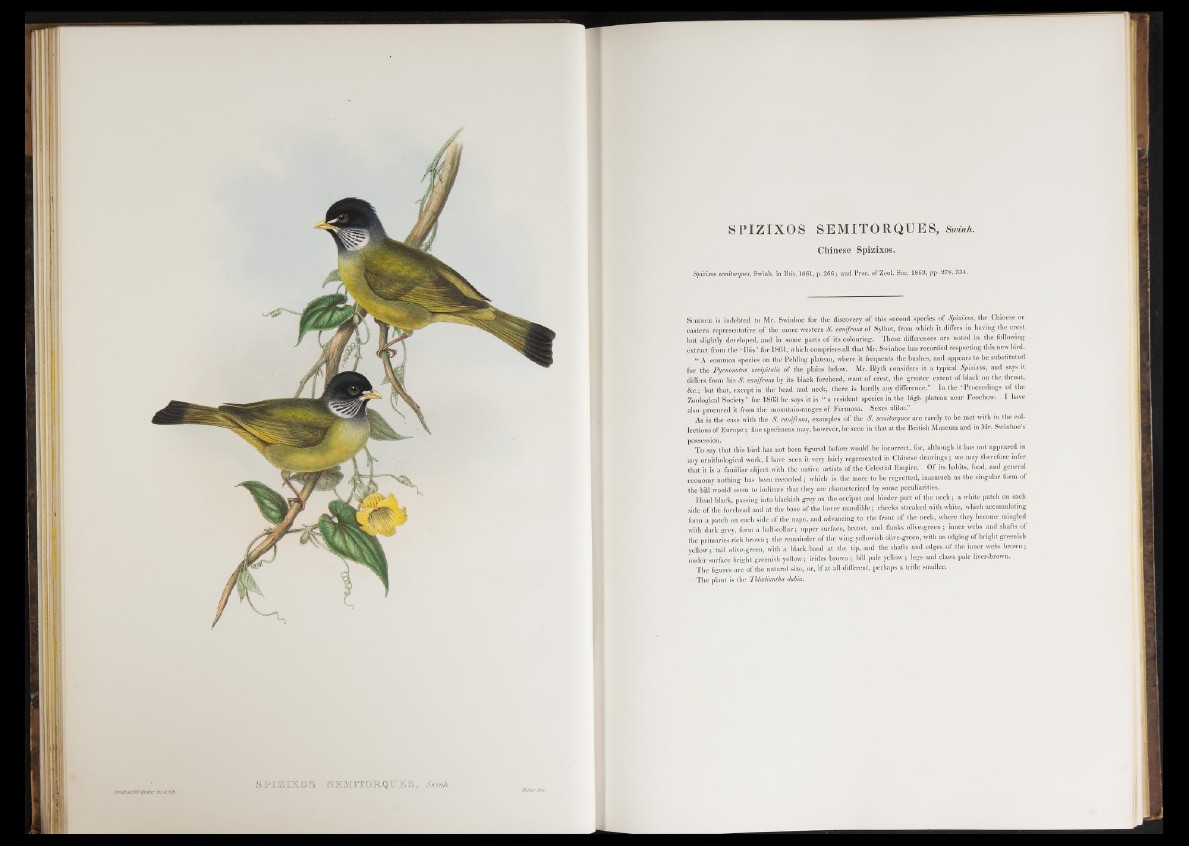
S P IZ IX O S 8 EMITOÄQTIES » Swinh.
SPIZIXOS SEMITORQUES, Sivinh.
Chinese Spizixos.
Spizixos semitorques, Swinh. in Ibis, 1861, p. 266 ; and Proc. o f Zool. Soc. 1863, pp. 278, 334.
S c ien c e is indebted to Mr. Swinhoe for the discovery of this second species of Spizixos, the Chinese or
eastern representative of the more western S . canifrous of Sylhet, from which it differs in having the crest
but slightly developed, and in some parts of its colouring. These differences are noted in the following
extract from the ‘ Ibis ’ for 1861, which comprises all that Mr. Swinhoe has recorded respecting this new bird.
“ A common species on the Pehling plateau, where it frequents the bushes, and appears to be substituted
for the Pycnonotus occipitalis of the plains below. Mr. Blyth considers it a typical Spizixos, and says it
differs from his S. canifrons by its black forehead, want of crest, the greater extent of black on the throat,
&c.; but that, except in the head and neck, there is hardly any difference.” In the ‘ Proceedings of the
Zoological Society’ for 1863 he says it is “ a resident species in the high plateau near Foochow. I have
also procured it from the mountain-ranges of Formosa. Sexes alike.”
As is the case with the S. canifrons, examples of the S. semitorques are rarely to be met with in the collections
of Europe; fine specimens may, however, be seen in that at the British Museum and in Mr. Swinhoe s
possession.
To say that this bird has not been figured before would be incorrect, for, although it has not appeared in
any ornithological work, I have seen it very fairly represented in Chinese drawings; we tnay therefore infer
that it is a familiar object with the native artists of the Celestial Empire. Of its habits, food, and general
economy nothing has been recorded; w h i c h || the more to be regretted, inasmuch as the singular form of
the bill would seem to indicate that they are characterized by some peculiarities.
Head black, passing into blackish grey on the occiput and hinder part of the neck ; a white patch on each
side of the forehead and at the base of the lower mandible; cheeks streaked with white, which accumnlating
form a patch on each side of the nape, and advancing to 'th e front of the neck, where they become mingled
with dark grey, form a half-collar; upper surface, breast, and flanks olive-green; inner webs and shafts of
the primaries rich brown ; the remainder of the wing yellowish olive-green, with an edging o f bright greenish
yellow; tail olive-green, with a black band a t the tip, and the shafts and edges of the inner webs brown;
nnder surface bright greenish yellow; irides brown ; bill pale yellow ; legs and claws pale liver-brown.
The figures are of the natural size, or, if at all different, perhaps a trifle smaller.
The plant is the Thladiantha dubia.